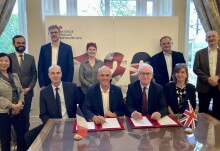

New model could make industrial processes more efficient and cost effective <em>- News</em>
See also
Related news stories
Friday 21 August 2009
By Colin Smith
A theory for predicting the properties of liquids and gases has been turned into new virtual modelling tool, which scientists say could revolutionise parts of industry.
Many industries use mixtures of chemicals and subject them to a range of temperatures and pressures to make household items such as plastics, shampoos and petroleum products.
Traditionally, chemists and engineers carried out thousands of experiments before manufacturing to ensure that such products were reliable and that the industrial processes used to make them were economical, safe and environmentally sustainable. However, this process was time consuming and costly.
Now, researchers at Imperial College London have developed the Statistical Associating Fluid Theory (SAFT) computer software to predict what happens to the chemical properties of the materials that industries are working with. This should mean that industries can improve their formulations and devise upgrades for industrial processes to make them more efficient and cost effective.
In the 1980s, Imperial’s Professor George Jackson along with Professor Walter Chapman, Professor Keith Gubbins and Professor Mac Radosz from Cornell University developed the Statistical Associating Fluid Theory. This theory helped engineers to carry out complex mathematical studies to predict what would happen to liquids and gases when they underwent industrial processes. It also enabled them to reduce the number of experiments needed and improved production processes and productivity.
After moving to Imperial in the 1990s, Professor Jackson and his team in the Department of Chemical Engineering and Chemical Technology including Dr Claire Adjiman and Dr Amparo Galindo, developed a number of new improvements to the theory including SAFT-VR and SAFT-y.This meant the theory could be applied more widely. However, the complexity of SAFT mathematical formulas restricted its use to a limited number of experts.
Researchers using the SAFT tool can work determine how to separate seawater from oil
Now, Imperial researchers have developed the SAFT computer modelling tool, which does all the complex calculations that an expert would normally carry out. This means that companies, whose staff do not have SAFT expertise can now use the SAFT computer tool to model what happens to the materials that they are working with.
The SAFT technology has now been licensed through an Imperial spin out company called Process Systems Enterprise, which will deliver the SAFT technology to a world-wide market as part of its gPROMS advanced process modelling technology. gPROMS is used widely by chemical process industries around the world to design plants and improve their operations. Dr Galindo says:
“We’ve now developed computer software that is compatible with the needs of industry. It will really open up new opportunities for companies to exploit SAFT to improve their industrial processes.”
The researchers say the SAFT computer modelling tool will be of real benefit to industries when they are designing new chemical processes. For example, engineers developing new technologies to capture and store CO2 from coal fired power stations could also benefit from SAFT computer modelling.
This process is known as Carbon Capture and Storage (CSS) and it relies on the CO2 being filtered through a solvent, which captures and separates the CO2 from other non-harmful emissions. The Imperial scientists say that the SAFT computer modelling tool could determine how much CO2 is absorbed by the solvent. The engineers could also use it to find better ways of improving the absorption process through the design of better solvents and more effective refining processes.
The researchers say that the oil industry could also benefit from using the SAFT computer modelling tool. When oil is extracted from under the sea it is mixed with seawater, which needs to be separated out of the oil.
Each ocean has different levels of saltiness, which affects how much oil can be extracted. The engineers could use the SAFT models to determine what chemicals and solvents are needed to counteract the salt so that they could maximise how much oil they retrieve from underground reservoirs. In turn, the SAFT model could also be used to calculate how much oil residue is left in the saltwater, so that further refinements could be carried out to ensure that the saltwater is clean enough to be recycled back into the ocean.
Article text (excluding photos or graphics) available under an Attribution-NonCommercial-ShareAlike Creative Commons license.
Photos and graphics subject to third party copyright used with permission or © Imperial College London.





